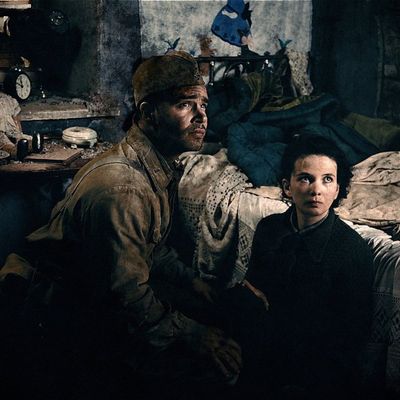
If you thought┬áSaving Private Ryan┬áneeded to be more like┬á300, then┬áStalingrad┬áis the movie for you. In Fedor BondarchukÔÇÖs ginormous look at the struggle for this Russian city ÔÇö one of the bloodiest, most-drawn-out battles of World War II, with nearly 2 million casualties ÔÇö the human cost of war is constantly upstaged by slo-mo happy, arena-size spectacle. This is the first Russian movie shot entirely in 3-D, which makes sense ÔÇö the battle for Stalingrad is practically a national creation myth. But while the imagery in this retelling is impeccable, the story is strangely lifeless.
Rather than recounting the whole siege, which took nearly half a year, BondarchukÔÇÖs film focuses on a small group of Russian soldiers who hide out in a bombed-out abandoned apartment building, with the only civilian among them Katya (Mariya Smolnikova), a teenage girl whose whole family has been killed along with all the other inhabitants. From the roof, one of the soldiers picks away at the German army across the rubble-strewn street. Meanwhile, the men form a small, vaguely dysfunctional community, complicated by their feelings of lust and protectiveness for Katya. ItÔÇÖs a promising setup ÔÇö like something Howard Hawks might have done, back in the day ÔÇö but the storytelling here never quite manages to cohere. The characters have things to say about the nature of duty, but they donÔÇÖt feel delineated or defined, and they never really come alive for us.
Oddly enough, the most interesting and human character in the film is one of the Nazis, a world-weary officer across the street (Thomas Kretschmann), who seems to have fallen in love with one of his Russian prisoners. ItÔÇÖs rare to find an enemy treated with such magnanimity in a national epic. (And to be fair, the Nazis still do horrific things in this movie.) But the film does seem to have an overall message of tolerance and hatchet-burying: The story is narrated by KatyaÔÇÖs grown son, now a graying Russian rescue worker struggling to save a group of German kids amid the rubble of the 2011 Japanese earthquake. How odd, though, that a film thatÔÇÖs relatively fair to one of its ostensible villains is so unable to bring its own heroes into sharper relief.
But, of course, that story is not the main attraction here. Stalingrad is an indulgence in spectacle all the way, and itÔÇÖs full of haunting, beautiful images ÔÇö the burning city, glimpsed in the distance from the Volga River, for instance, or a stunning nighttime charge by a group of burning Russian soldiers, set alight by an exploding fuel depot. It all deserves to be seen on the biggest screen possible. But at the same time, is it possible for something to be too beautiful? These impeccably constructed battle scenes are less like scenes from hell and more like snow globes of combat ÔÇö precise, beautiful, and synthetic. It might have worked if the story itself supported the unreal nature of the battle ÔÇö as it does in Joe WrightÔÇÖs similarly exquisite Atonement, a film that turns its absurdist, artificial vision of war into a sly commentary on its narrative. Meanwhile, Bondarchuk seems overtly fond of slow-motion and speed ramping, but his reliance on the technology is misplaced: It does nothing to enhance the nature of the combat, because what weÔÇÖre seeing arenÔÇÖt elaborate physical feats. The slo-mo removes the horror and renders everything strangely clean. That might work with martial arts, where capturing the acrobatic grace of the fighting is crucial. Here, it backfires.
The director, however, has grandiosity coursing through his veins; heÔÇÖs the son of the great Sergei Bondarchuk, who starred in and directed the magnificent 1966 Soviet War and Peace, which ran seven hours and is still the most expensive film ever made ÔÇö so expensive that it didnÔÇÖt technically have a price tag. (He also made his own rather moving WWII epic, 1975ÔÇÖs They Fought for Their Country.) Father SergeiÔÇÖs exhaustive treatment of the classic novel was also at times impeccably beautiful, but it also had TolstoyÔÇÖs melodrama and characters to bolster its images; the spectacle didnÔÇÖt just float there between the winds, as it does here. Stalingrad carries on the family tradition of making intensely watchable epics shot through with moments of grandeur. Just donÔÇÖt be surprised if you find yourself twiddling your thumbs in between such moments, losing patience with the whisper-thin story and cardboard characters.


